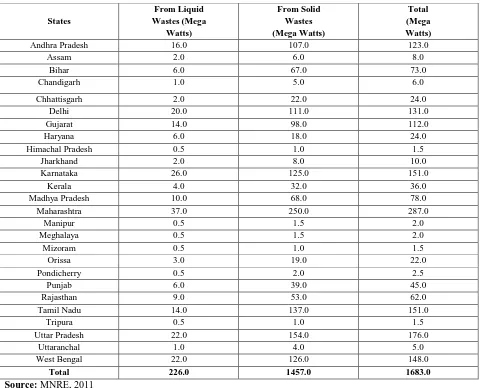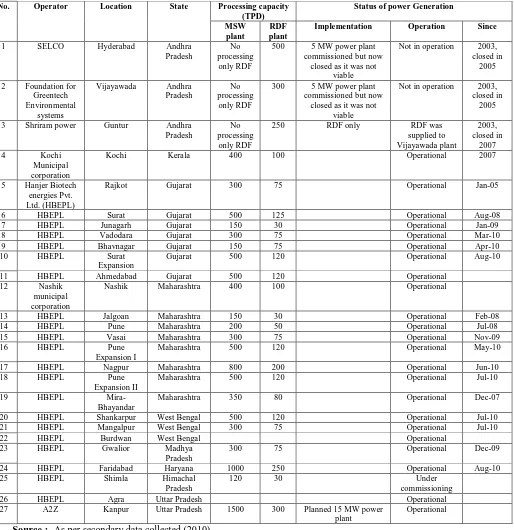Utilization of Refuse – Derived Fuel (RDF) As
an Alternative Energy Resource in India
Poornima Shuklaˡ, R. K. Srivastava²
Research Scholar, Environmental Research Laboratory, P.G. Department of Environmental Science, Government
Model Science College (Autonomous), Jabalpur (M.P.), India ˡ
Assistant Professor, Environmental Research Laboratory, P.G. Department of Environmental Science, Government
Model Science College (Autonomous), (NAAC Re-Accredited ‘A’ Grade), College with Potential for Excellence
(UGC), Jabalpur (M.P.), India ²
ABSTRACT: India is one of the rapidly developing country. The increase in socio-economic condition has also significantly increased the amount of municipal solid waste generated. The proper disposal of MSW become a big challenge for local authorities. The traditional landfill method requires large amounts of land and contaminate air, water and soil. The environmental benefits of refuse-derived fuel, as an alternative technology for disposing of huge amount of solid waste. MSW has a very good calorific value which makes it a good source of energy. RDF can be used as a fuel and raw material substitute in various energy intensive plants like industries, power plants etc. Refuse derived fuel from municipal solid waste can be an alternative form of energy to replace fossil fuels. It is increasingly perceived as a suitable option for municipal solid waste management in India as it is if correctly applied- environment friendly and resource efficient.
KEYWORDS: Refuse-derived fuel, MSW, Calorific value, Landfill, Environment friendly.
I. INTRODUCTION
The global demand for energy is rapidly increasing with increasing human population, industrialization, urbanization and modernization. In modern time developing countries like India most of the electricity requirements are met by conventional sources. The non-renewable source of energy, coal continues to be the most important source of electricity generation in India (Mandloi, 2015; Surroop and Mohee, 2011).
Table 1 : Typical composition of MSW
S. No. General waste component Mass content
01 Easily degradable 35-40 %
02 Combustible/ long term degradable 15-20 %
03 Recyclables/Combustibles 15-20 %
04 Other materials 20-25 %
Source:- CPCB Report 2012 .
The main advantages of using RDF as a fuel are an important reduction in the volume of solid waste and the possibility of energy recovery. Nowadays a number of industries are interested in this type of fuel (Gallardo et al, 2015). Refuse derived fuel has good calorific value, it also has least polluting bi-products and its usage leads to a proper solid waste management as well. The refuse derived fuel technology (RDF) developed in 1970, offers a alternative technique to mass burning of municipal solid waste and low cost of solid waste disposal. The term refuse derived fuel (RDF) is used for the segregated high calorific value fractions of processed municipal solid waste (Johari et al. 2014). RDF are increasingly used as a low-cost and regionally available energy source for cement works all over the world. In many European countries already more than 70% of the overall energy consumptions of cement manufactures is covered by RDFs (Schwarzbock et al. 2016 ; Chatziaras et al. 2016; Hajinezhad et al. 2016). Study shows that RDF has considerable potential for removal of colouring agent from waste water over a wide range of concentrations (Vanjara, 1998).
Information on the chemical composition of MSW is essential in evaluating alternative processing and recovery technologies. If solid wastes are to be used as fuel for energy production, the four most important properties to be known are proximate analysis (Moisture, volatile matter, ash & fixed carbon), ultimate analysis (% of C, H, O, S,N), densified refuse derived fuel composition (percentage of plastic, textile, paper etc.) (Kothari and Thorat, 2014; Pohl et al. 2008). RDF has better emission characteristics in comparison to coal. There is no sulphur in RDF. It won’t emit any harmful gases like Carbon di oxide, methane etc. This table shows comparison of calorific values and characteristics of RDF available in India and Bituminous coal (Mandloi, 2015).
Table 2 :- Comparison of RDF and Coal calorific values and characteristics
S. No. Calorific values and characteristics
RDF (Refuse Derived Fuel) Coal (Bituminous)
01 Calorific value 3,500-4,000 K.cal/Kg (Depends on the
volatile waste material in the MSW)
02 Pollutants Nil Sulphar dioxide, Nitrogen oxides,
Particulate matter, Mercury
03 Boiler efficiency 53% 48%
04 Cost 15910.29 INR/Tonne i.e. 15.9 INR/Kg 1,700 INR/Tonne i.e. 1.7 INR/Kg
Refuse derived fuel (RDF) from municipal solid waste can be an alternative form of energy to replace non- renewable fuels or fossil fules.
II. WASTE TO ENERGY POTENTIAL IN INDIA
industrial waste (Chouhan et al. 2015; Sriram, 2015). State wise potential of energy recovery from urban and industrial waste in India is given in table 3.
Table 3:- Potential of Energy Recovery from Urban and Industrial Wastes in India.
States
From Liquid Wastes (Mega
Watts)
From Solid Wastes (Mega Watts)
Total (Mega Watts)
Andhra Pradesh 16.0 107.0 123.0
Assam 2.0 6.0 8.0
Bihar 6.0 67.0 73.0
Chandigarh 1.0 5.0 6.0
Chhattisgarh 2.0 22.0 24.0
Delhi 20.0 111.0 131.0
Gujarat 14.0 98.0 112.0
Haryana 6.0 18.0 24.0
Himachal Pradesh 0.5 1.0 1.5
Jharkhand 2.0 8.0 10.0
Karnataka 26.0 125.0 151.0
Kerala 4.0 32.0 36.0
Madhya Pradesh 10.0 68.0 78.0
Maharashtra 37.0 250.0 287.0
Manipur 0.5 1.5 2.0
Meghalaya 0.5 1.5 2.0
Mizoram 0.5 1.0 1.5
Orissa 3.0 19.0 22.0
Pondicherry 0.5 2.0 2.5
Punjab 6.0 39.0 45.0
Rajasthan 9.0 53.0 62.0
Tamil Nadu 14.0 137.0 151.0
Tripura 0.5 1.0 1.5
Uttar Pradesh 22.0 154.0 176.0
Uttaranchal 1.0 4.0 5.0
West Bengal 22.0 126.0 148.0
Total 226.0 1457.0 1683.0
Source: MNRE, 2011
III. STATUS OF RDF PLANTS USED FOR POWER GENERATION IN INDIA
Table 4 :- Status of RDF Plants in India
No. Operator Location State Processing capacity
(TPD)
Status of power Generation
MSW plant
RDF plant
Implementation Operation Since
1 SELCO Hyderabad Andhra
Pradesh
No processing
only RDF
500 5 MW power plant
commissioned but now closed as it was not
viable
Not in operation 2003,
closed in 2005
2 Foundation for
Greentech Environmental
systems
Vijayawada Andhra
Pradesh
No processing
only RDF
300 5 MW power plant
commissioned but now closed as it was not
viable
Not in operation 2003,
closed in 2005
3 Shriram power Guntur Andhra
Pradesh
No processing
only RDF
250 RDF only RDF was
supplied to Vijayawada plant
2003, closed in
2007
4 Kochi
Municipal corporation
Kochi Kerala 400 100 Operational 2007
5 Hanjer Biotech
energies Pvt. Ltd. (HBEPL)
Rajkot Gujarat 300 75 Operational Jan-05
6 HBEPL Surat Gujarat 500 125 Operational Aug-08
7 HBEPL Junagarh Gujarat 150 30 Operational Jan-09
8 HBEPL Vadodara Gujarat 300 75 Operational Mar-10
9 HBEPL Bhavnagar Gujarat 150 75 Operational Apr-10
10 HBEPL Surat
Expansion
Gujarat 500 120 Operational Aug-10
11 HBEPL Ahmedabad Gujarat 500 120 Operational
12 Nashik
municipal corporation
Nashik Maharashtra 400 100 Operational
13 HBEPL Jalgoan Maharashtra 150 30 Operational Feb-08
14 HBEPL Pune Maharashtra 200 50 Operational Jul-08
15 HBEPL Vasai Maharashtra 300 75 Operational Nov-09
16 HBEPL Pune
Expansion I
Maharashtra 500 120 Operational May-10
17 HBEPL Nagpur Maharashtra 800 200 Operational Jun-10
18 HBEPL Pune
Expansion II
Maharashtra 500 120 Operational Jul-10
19 HBEPL Mira-
Bhayandar
Maharashtra 350 80 Operational Dec-07
20 HBEPL Shankarpur West Bengal 500 120 Operational Jul-10
21 HBEPL Mangalpur West Bengal 300 75 Operational Jul-10
22 HBEPL Burdwan West Bengal Operational
23 HBEPL Gwalior Madhya
Pradesh
300 75 Operational Dec-09
24 HBEPL Faridabad Haryana 1000 250 Operational Aug-10
25 HBEPL Shimla Himachal
Pradesh
120 30 Under
commissioning
26 HBEPL Agra Uttar Pradesh Operational
27 A2Z Kanpur Uttar Pradesh 1500 300 Planned 15 MW power
plant
Operational
IV. GENERAL PROCESS OF RDF PREPARATION
The municipal solid waste (MSW) is processed to improve the physical and chemical properties of solid waste. During the process non-combustible material such as glass and metals are removed. Next step it is crushed into small particles. The product of processing is further processed and fine clay and sand particles are segregated from it. And eventually on drying a combustible fuel, refuse derived fuel in pellets form is obtained for power generation (Mandloi, 2015).
Source:- http://wastebusters.com.pk/refuse-derived-fuel/
V. CONCLUSION
REFERENCES
1) Chouhan MS, Verma S, Sharma S, Mehta N “Review on waste to energy potential in India” International Journal of Chemical Studies, 2015,
Vol. 2(5), pp. 51-53.
2) Chatziaras N, Psomopoulos CS, Themelis NJ, “Use of waste derived fuels in cement industry: a review” Management of Environmental
Quality: an international journal, 2016, Vol. 27 No. 2, pp. 178-193.
3) Dube R, Nandan V, Bineesha P, Dua S, “Status paper on utilization of refuse derived fuel (RDF) in India” prepared by Deutsche Gesellschaft
fur internationale Zusammenarbeit (GIZ) GmbH under the Indo-German Environment Partnership (IGEP), 2013.
4) Gallardoa A, Carlosb M, Boveac MD, Colomerd FJ, Albarrane F, “Analysis of refuse-derived fuel from the municipal solid waste reject
fraction and its compliance with quality standards” 2015, pp. 1-15.
5) Hajinezhad A, Halimehjani EZ, Tahani M, “Utilization of refuse-derived fuel (RDF) from urban waste as an alternative fuel for cement factory:
a case study” International journal of renewable energy research, 2016, Vol. 6, No.2, pp. 702-714.
6) Jain P, Handa K, Paul A, “Studies on waste-to-energy technologies in India & a detailed study of waste-to-energy plants in Delhi” International
journal of advanced research, 2014, Vol. 2, Issue 1, pp. 109-116.
7) Johari A, Mat R, Alias H, Hashim H, Hassim MH, Zakaria ZY & Rozainee M, “Combustion characteristics of refuse derived fuel (RDF) in a
fluidized bed combustor” Sains Malaysiana , 2014, Vol. 43(1), pp. 103–109.
8) Kothari DC and Thorat PV, “d-RDF (refused derived fuel) for smart–cities of India” International journal of advanced research in chemical
science (IJARCS), 2014, Vol. 1 issue 8, pp. 14-21.
9) MNRE (Ministry of New and Renewable Energy). National master plan for development of waste-to- energy in India. Ministry of Environment
and Forests, 2011.
10) Mandloi D, “RDF (refuse derived fuel): an alternate energy resource” indian journal of research, 2015, vol. 4 issue 7, pp. 257-259.
11) Ouda OKM and Raza SA, “Waste-to-energy: solution for municipal solid waste challenges- global perspective” 2014 International Symposium
on Technology Management and Emerging Technologies (ISTMET), 2014, pp. 270-274.
12) Pohl M, Gebauer K, Beckmann M, “Characterisation of refuse derived fuels in view of the fuel technical properties” INFUB - 8TH European
conference on industrial furnaces and boilers (Vilamoura-Algarve, Portugal), 2008.
13) Sriram S, “refuse derived fuel: future energy source in India” International Journal of Application of Engineering and Technology, 2015, Vol-2
No.-5, pp. 273-277.
14) Sheth K.N., “Refused derived fuel - an emerging processing technology for municipal solid waste management” 9th International Conference
on Engineering and Business Education (ICEBE) & 6th International Conference on Innovation and Entrepreneurship (ICIE), 2016, pp. 176-182.
15) Schwarzbock T, Munawar E, Lederer J, Fellner J, “Refuse derived fuels in the cement industry–potentials in Indonesia to curb greenhouse gas
emissions” International Conference on Engineering and Science for Research and Development (ICESReD), 2016, pp.219–227.
16) Surroop D and Mohee R, “Power generation from refuse derived fuel” 2011 2nd International Conference on Environmental Engineering and
Applications IPCBEE vol.17, 2011, pp. 242-246.
17) Vanjara AK, “Colour removal from textile effluent using refuse derived fuel as an adsorbent” Indian journal of chemical technology, 1998, Vol.


